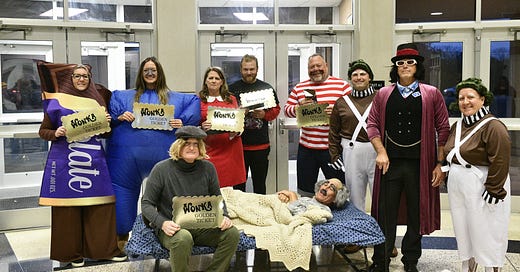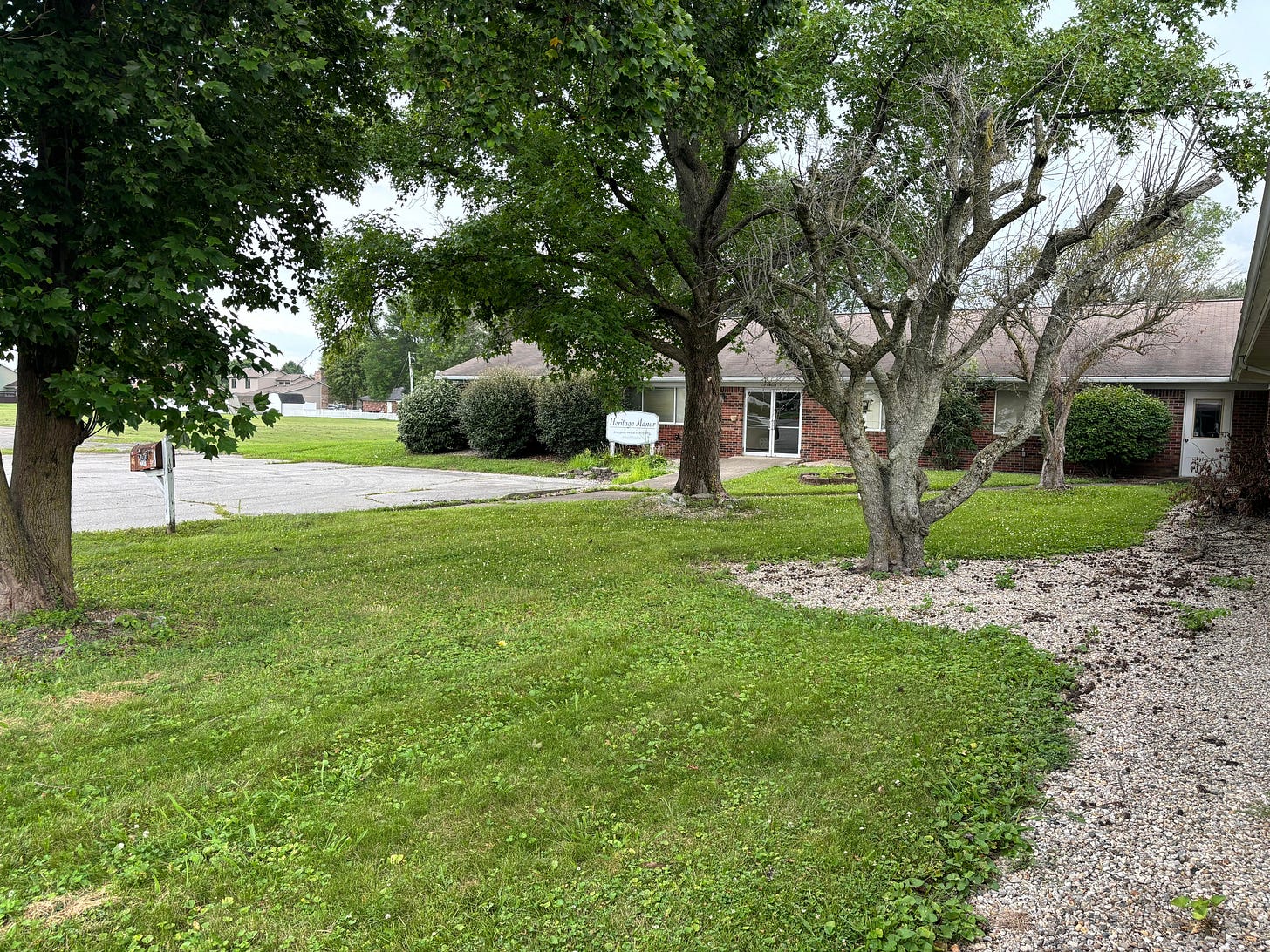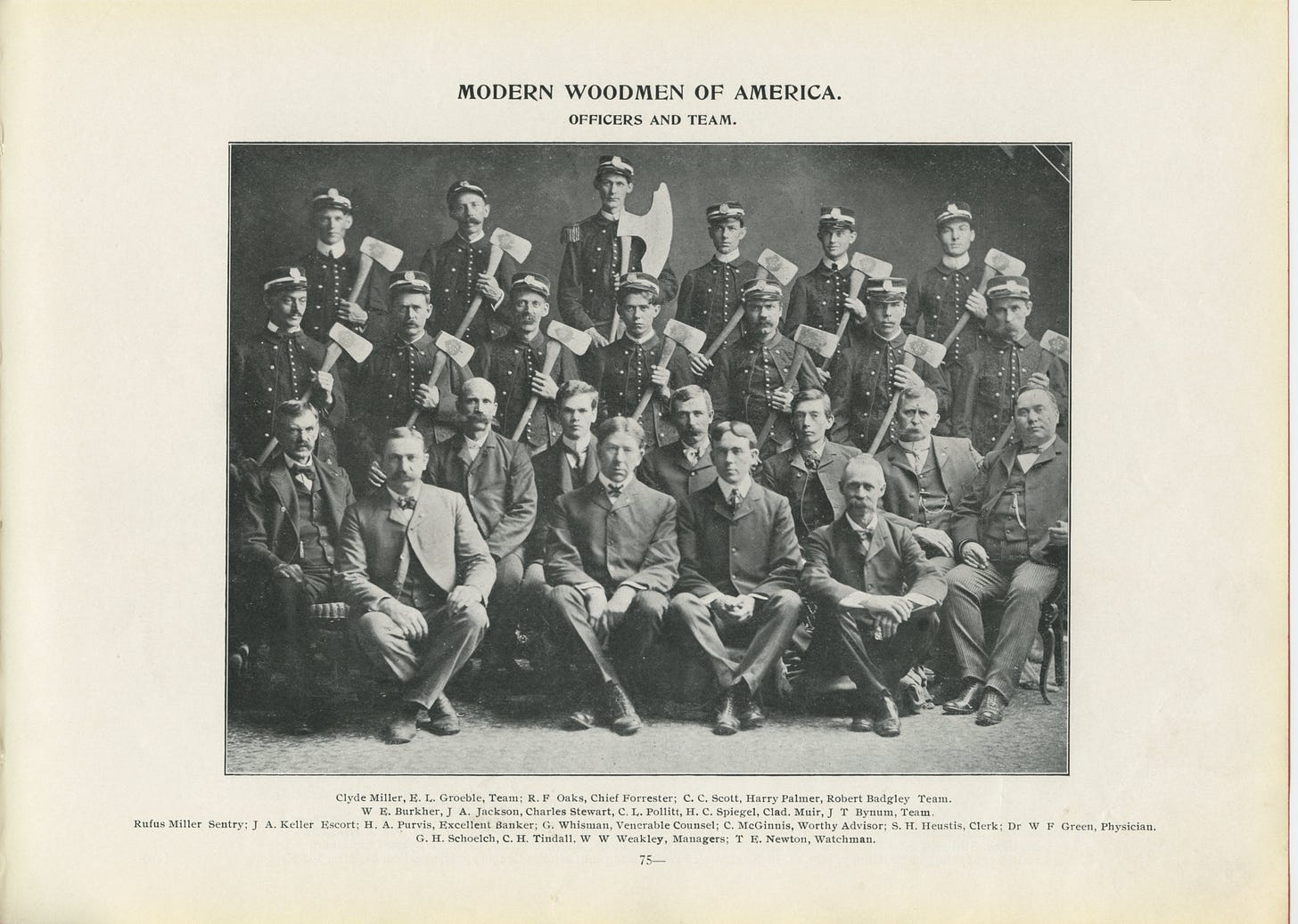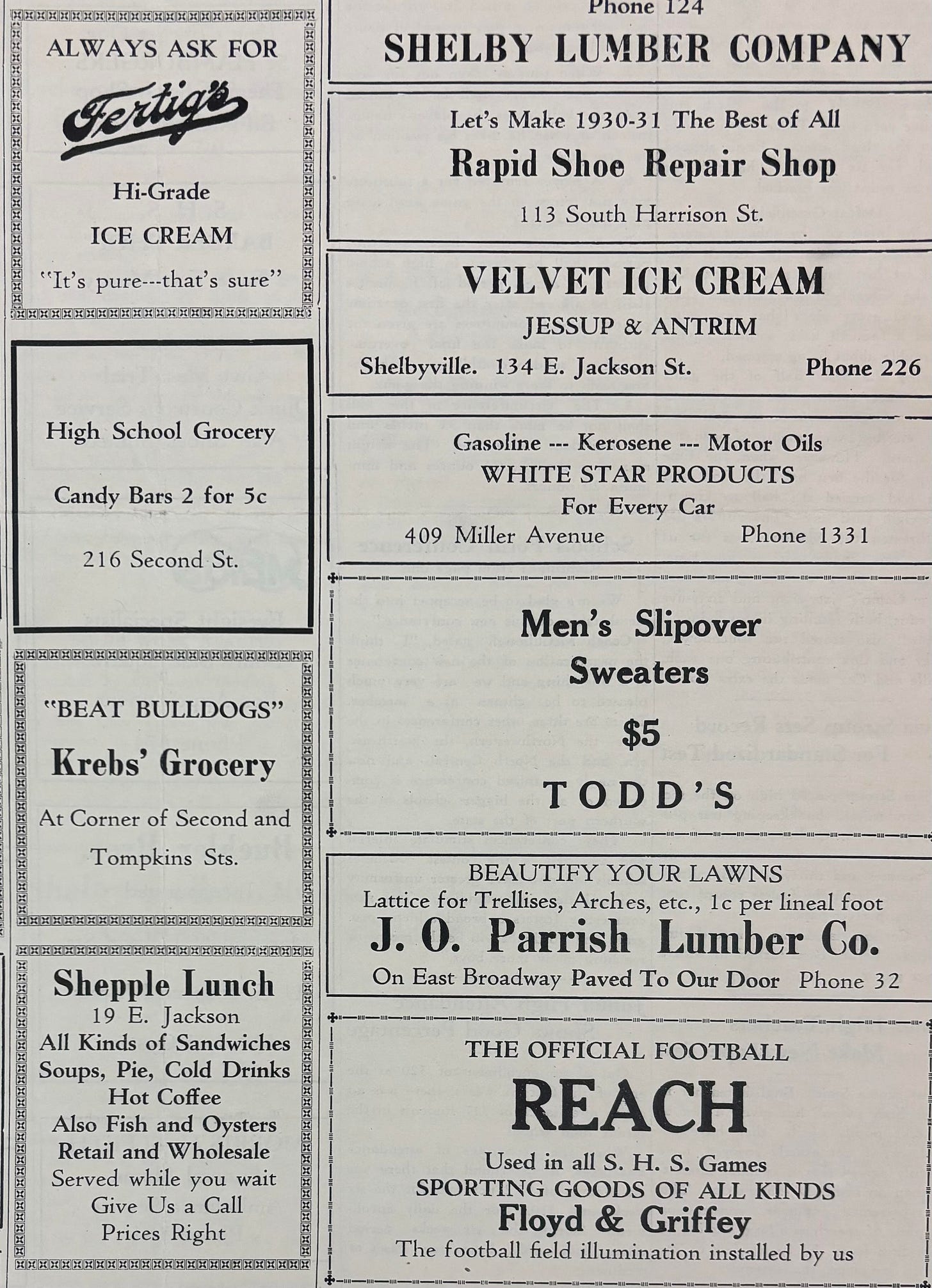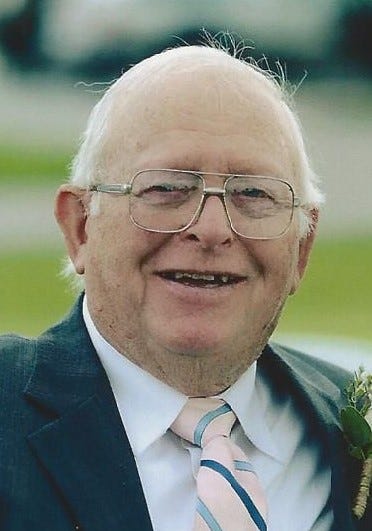OVER-THE-TOP HALLOWEEN
Although the entire Shelbyville High School faculty dresses up each year for Halloween, the math and business departments went above and beyond to depict Charlie and the Chocolate Factory. Back row, L to R: Tabitha Cole, Kayla Sitton, Kimberly Ferguson, Coen Weiler, Luke Stout, Andrew Nance, Mark Hensley and Arielle Nance; front, Greg Branson and Rick Zimny. | photo by KRISTIAAN RAWLINGS
Non-Profit Center to Receive READI Funding
The Non-Profit Center is slated to be located at 2311 S. Miller St. | Addison Times File Photo
Media Release
READI 2.0 state funding will support the development of a new Non-Profit Center in Shelbyville, Accelerate Rural Indiana (ARI) officials announced yesterday.
“This new non-profit center in Shelby County will not only help community-focused organizations operate more efficiently, but will also make it easier for Hoosiers across the region to learn about and access the critical services these non-profits provide, thereby bettering the quality of life for individuals and the community at large,” Gov. Eric Holcomb said in a media release.
The $8.5 million project (including a $1 million READI 2.0 allocation) will redevelop a long-vacant 30,000-square-foot former nursing home into a Non-Profit Center designed to host social services-oriented community organizations and help supporters and those in need of services navigate Shelby County’s 200-plus non-profits. The centralized facility, on S. Miller St. in Shelbyville, will help like-minded organizations streamline referrals and collaboration opportunities while creating a more coordinated approach to tackling complex challenges, such as transportation, housing and food access.
The new facility will be operated by Healthy Shelby County, a nonprofit that has long served the community, and will feature incubation space, a centralized food pantry, an industrial kitchen, visitation space, a family resource center, navigator services, a computer lab and showers. Construction is expected to begin by June 2025, and the facility is planned to open in January 2026.
“On behalf of Healthy Shelby County, we are grateful for the financial support of ARI, which is a demonstration of the regional commitment to support residents and neighbors in their time of need,” said Stephen Black, president of Healthy Shelby County. “Shelby County has many nonprofit organizations dedicated to caring for neighbors through their most vulnerable and challenging moments in life. To pull those resources together under one roof embodies the idea that the whole is greater than the sum of the parts. This is truly a force multiplier for Shelby County and the region.”
NOTEBOOK:
West Broadway St. resident David Finkel reported 1,200 trick-or-treaters at his home by 7:20 p.m. last night.
The annual Major Women’s Alliance Style Show will be held a week from today, Friday, Nov. 8, at Horseshoe Indianapolis Casino. All proceeds from the 2024 Style Show will go to support the newly developed MAJOR WISH fund to grant oncology patients their special wish. (Seven wishes have been granted so far; the wishes range from house cleaning, spa day, family day out and funds to contribute towards a trip to see the ocean for the first time.) Tickets can be purchased at this link or at the MHP Gift Shop. “Our goal with this event is to make the wishes bigger!” LaTisha Idlewine, MHP Foundation Executive Director, said.
Morristown Methodist Church, 221 S. Washington St., Morristown, is hosting a fundraising Turkey-Noodle Dinner on Saturday, Nov. 9, 4:30 - 7 p.m., $10/meal, dine-in or carry-out.
NATIONAL NEWS: The NHL has been doing great, with big sales at the top of the league — a $1.8 billion price for the Tampa Bay Lightning — and increasingly solvable problems at the bottom of the league, like exiling the Arizona Coyotes to Utah. As a result, and thanks as well to high expectations for an especially lucrative Canadian television deal, valuations for NHL teams are way up, hitting $1.79 billion according to Sportico, up 37 percent compared to 2023 and up 92 percent since 2021. (Sportico/Numlock)
The Addison Times publishes essential news and historical content to build our Shelby County community, and is free thanks to the generosity of supporters. Those who donate $15 minimum one-time receive the remaining quarterly Addison Times magazine for 2024 as an appreciation gift. Support The Addison Times here!
Want the daily edition read to you? Struggling with your email provider filtering out your local news? The Addison Times Substack app will solve those challenges!
Modern Woodmen of America: A Legacy of Financial Protection and Community Service
by GEORGE YOUNG
Shelbyville Fraternal Organization Series
Modern Woodmen of America was one of many fraternal lodges in Shelbyville in 1902. Founded in 1883, Modern Woodmen of America was inspired by the pioneer woodmen who cleared forests to build homes, secure communities, and provide for their families. While the name evokes images of woodworkers, the organization was never involved in lumberjacking or carpentry. Instead, it was established to help clear financial burdens for families, a mission envisioned by its founder, Joseph Cullen Root. This fraternal financial services organization has protected families and supported communities for over a century.
Origins and Early Purpose
The roots of Modern Woodmen’s mission trace back to the concept of life insurance, which dates as far back as 100 B.C. Fraternal benefit societies were first formed in the mid-1800s to assist families after the death of a breadwinner. Inspired by these early models, Root founded Modern Woodmen of America on January 5, 1883, in Lyons, Iowa. The organization quickly expanded, moving to Fulton, Ill., in 1884, and then to Rock Island, Ill., in 1897, where it remains headquartered today.
Root chose the name “Modern Woodmen” to symbolize the pioneers who cleared land for the security of their families. This was an ideal metaphor for Root’s goal: clearing financial hardships for families. The organization grew rapidly, fostering a strong sense of community through its fraternal structure.
Initially, the organization had strict membership requirements. Members had to be white males between the ages of 18 and 45 and reside in one of 12 “healthiest” states, including Ohio, Illinois, and the Dakotas. Those in dangerous professions, such as miners, railway workers, and even baseball players, were excluded. Over time, these restrictions were loosened, and by the mid-1900s, the organization had become more inclusive.
In response to the tuberculosis epidemic of the early 1900s, Modern Woodmen opened a sanatorium in Colorado Springs in 1907, providing free treatment to over 12,000 members until its closure in 1947. The facility cost $1.5 million ($50 million today) to build and was named one of the most outstanding institutions for the treatment of TB by the American College of Surgeons. The 1,000-acre facility, one of the largest of its kind, offered innovative treatments, including high-altitude air therapy and a diet rich in eggs and milk. With a 60 percent cure rate, the sanatorium was hailed as one of the premier institutions for TB treatment by the American College of Surgeons.
Community Impact Today
Modern Woodmen has continued to evolve while maintaining its core values of protecting families and strengthening communities. Today, with nearly 700,000 members nationwide, the organization operates 2,466 chapters, 283 Summit chapters, and 782 youth service clubs. Each year, it facilitates $40 billion in life insurance and donates $18 million to programs and activities benefiting local communities.
Throughout its history, Modern Woodmen upheld strict moral standards. During Prohibition, bootleggers were banned from membership. Despite these changes, the organization remains committed to its fraternal roots and is dedicated to helping families and communities as it was founded in 1883.
Modern Woodmen were originally organized around local chapters known as “camps” and regional offices called “districts.” They often participated in ceremonial rituals involving military-style uniforms, visored hats, symbolic axes, wedges, and beetles representing industry, power, and progress. This structured system of roles and responsibilities, combined with the regular social events, would have fostered a sense of belonging and purpose among members, contributing to the lodge's ongoing growth and relevance in the community.
The lodge had a well-structured hierarchy, with numerous offices that played key roles in its operations. There were several notable positions. Venerable Consul: Likely the chief officer, overseeing the lodge's overall functions; Worthy Advisor: A position providing guidance and counsel, possibly in decision-making or ritual matters; Excellent Banker: Responsible for managing the lodge's finances, ensuring funds were properly accounted for; Escort: Likely charged with ceremonial duties, assisting with rituals and events; Watchman and Sentry: These roles were likely responsible for maintaining order and security during meetings; Physician: A position indicating that the lodge cared for the well-being of its members; Manager: An administrative role focused on the day-to-day logistics and organization of lodge activities.
The Shelbyville Lodge was a vibrant hub of social activity, frequently hosting gatherings and events that fostered camaraderie and fellowship among its members. One notable tradition was organizing events like “smoker and possum” suppers, which were typically held at the Grand Army of the Republic (G.A.R.) hall. These events provided an informal and convivial atmosphere for members to engage in fellowship, initiate new members, and process membership applications. Such gatherings were essential for the lodge's culture, offering business and social interaction opportunities.
You will remember Charles H. Tindall from the 1911 Honor Court incident. In 1902, he was appointed the lodge’s manager, placing him at the heart of these activities. As manager, Tindall would have overseen coordinating events, managing membership records, and other logistical tasks, ensuring the smooth operation of the lodge's social and administrative functions. It appears he was deeply involved in several lodges for many years.
SHS Courier Archive Highlights:
Oct. 24, 1930
Courier staff members approached W.F. Loper about making Tompkins a through-street. Loper liked the idea, and suggested there be a specified street for bicycle traffic to and from school. Lora Pearson, principal of Colescott school, agreed with the need for changes. “The corner of Tompkins and Colescott is a very dangerous intersection,” she said. City Council member Eden Thurston also said he was on board. The proposal would make Tompkins a through-street from Broadway to Third St., except at the intersection of Colescott, where there would be a four-way stop.
The Courier adopted a code of ethics, which included, “Be truthful. Get the facts. Be decent. Boost, don’t knock. There’s good in everybody. In getting the facts, tell the story as it is, not as you would like to have it. If it can possibly be avoided, never bring ignominy on an innocent man or child, in telling of the misdeeds or misfortune of a relative. And, above all, be clean. Never let a dirty word or suggestive story get into type, or in your mind.”
Mr. Knaub got onto Wayne Cayton, “a very short freshman,” for trailing Edward Haehl, six-feet-tall, every time Haehl got up to walk across the study hall, which “put the room in an uproar.” Knaub “had a conference with Wayne” about the matter.
Gym uniforms were mandated for the first time in the boys’ classes. Boys were to wear “white, washable suits.”
Goldie Means was elected president of the Shelby band, the first time the band had elected a president. Harold Hirschauer, SHS class of 1929, was appointed assistant conductor.
Half-time entertainment at the football game was provided by A.R. Patterson, who brought his “trick Ford” vehicle onto the field.
This Day in Shelby County History
News around Shelbyville and the surrounding area as reported on or about this date in history. Selections are curated from the Shelby County Public Library Genealogy Department.
2014: Editor’s note: Due to a microfilm processing error, the 2014 section for the next couple of weeks will serve to memorialize a local individual who passed away that year.) Lance Corporal Michael Tuttle, 21, former Fountaintown resident, died on base in Okinawa. At the request of Scott Spahr, a veteran of the Gulf War, local schools lowered flags in honor of Tuttle.
2004: The Morristown volleyball team won the South Decatur Regional. Members of the team were Erin Nigh, Megan Stout, Trista Wood, Stefanie Keffaber, Nicole Gentory, Stephanie Linville, Mary Nolen, Mikala Gentory, Heather Coyle, Chelsy Carlton, Hanna Miller, Chelsea Caldwell and Casey Gumberts. Rita Rouse was coach, Dena Caldwell was assistant coach and John Anderson was trainer.
1994: A new outdoor shrine in honor of the Virgin Mary was installed outside of St. Vincent Catholic Church. It sat where the area’s first Catholics had cleared land in 1826, and where its first priest, a French import named Vincent Baquelin, established the first Catholic church in this part of the state in 1837.
1984: Several people brought candy to be x-rayed at Major Hospital. No foreign objects were found.
A man was charged with attempted battery and criminal recklessness for throwing an ear of corn at Capt. Rick Joseph and his 18-month-old son. Joseph and his son had been sitting on the porch of his mother-in-law’s home, 24 Mildred St., when a passenger in a passing car hurled an ear of corn at them. Joseph hopped in his nearby patrol car and stopped the vehicle near the intersection of S. Harrison and Colescott streets.
1974: Emma Horner began her duties as a deputy probation officer. She had previously taught remedial reading courses. Her husband, Rev. James Horner, was pastor of First Christian Church.
1964: Local election officials said a heavy Election Day turnout was likely. A record number of absentee ballots had been cast already. Eight of the 15 school buildings in rural sections of the county would be closed in order to serve as polling places.
Sandra Van Arsdall, of St. Paul, was crowned Homecoming Queen at Evansville College.
1954: Warren Wilbur Shaw, acclaimed racecar driver and Shelbyville native, was killed with two others in a plane crash in northeastern Indiana. Shaw, who won the Indy 500 three times, liked to recall that he got his first racing “ride” at the Shelby County Fair goat race, before World War I. Shaw’s aunt, Lena Shaw, 1404 S. Harrison St., and her late husband, fireman Harry Shaw, had put Wilbur up to the race. He won $1 for winning the race after investing $40 in equipment. Some of his first goat racing equipment was still stored in a shed at Shaw’s home. Wilbur lived with his aunt Lena for a period of time after his parents’ separation and attended Shelbyville High School.
1944: Special events were planned to celebrate the first anniversary of The Rec, which had given young people “a lot of happy hours jitterbugging, sipping soft drinks and ‘clicking their teeth.’” The anniversary event included bringing your parents to a juke box dance. Once the parents were there, kids planned to “shake the guests loose from a considerable amount of change” to raise funds for the club.
Pfc. Anthony Runnebohm sent his Purple Heart award to his wife, Betty Runnebohm, in Shelbyville. Pvt. Runnebohm had suffered wounds in action in Italy on Sept. 11 and was confined to a military hospital in Italy.
1934: Brandishing a gun and flashlight, a highway bandit held up William Yarling and Elsie King, who had been in an automobile on the Franklin road. The bandits stole several items, then disconnected the ignition wires on the car, forcing Yarling and King to walk.
1924: It rained for the first time since Oct. 5, when it had rained only two-hundredths of an inch.
1914: Mrs. Charles McCain, school teacher at Marietta school, was injured while chopping wood to build a fire outside the school. Dr. Cohee treated the wound with stitches.
OBITUARIES
Helen M. Patterson, 94, of Shelbyville, passed away Monday, October 28, 2024, at Ashford Place. Born December 4, 1929, in Bartholomew County, she was the daughter of Thomas B. Johns and Sarah Pearl (Mink) Johns. She married James S. Patterson on October 7, 1949, and he preceded her in death on August 14, 2014.
Survivors include son, Jerry Patterson of Florida; niece, Beth Harding (Mike) of St. Paul; nephew Todd L. Johns (Christina) of St. Paul; great-niece Sarah Kuntz (Aaron) of Ft. Wayne; three great-nephews, Cody, Austin, and JT Johns, all of St. Paul; two great-great-nephews Aiden Kuntz and Oliver Johns. She was preceded in death by her parents, spouse, son Jay Patterson, brother Thomas L. Johns, sister-in-law Carolyn B. Johns, and great-niece Rachel Harding.
Helen had lived in this area most of her lifetime and graduated from Hope High School. She was employed in the insurance industry for many years. Helen enjoyed watching sports on TV, playing cards, reading books, and spending time with her family.
Graveside service will be 11 a.m., Monday, November 4, 2024, at Van Pelt Cemetery, 5711 E. River Road, Waldron with Rev. Mark Dodd officiating. Memorial contributions can be made to Rachel Harding Scholarship Fund through Blue River Foundation, in care of the funeral home. Online condolences can be shared at glennegeorgeandson.com.
William Robert “Bob” Beckner, 91, of Waldron, passed away, Thursday, October 31, 2024, at Decatur County Hospital in Greensburg. He was born November 23, 1932, in Rush County, the son of Russell and Maude (Meyer) Beckner. On April 1, 1955, he married his wife of 69 years, Roberta H. Burk, and she survives. In addition to Roberta, Bob is survived by his daughter, Mary H. Stephens of Waldron; son, Dean E. Beckner and wife, Karen, of Waldron; sister, Betty J. Baker of New Palestine; grandchildren, Krystal Barnard and husband, Justin, Russell Beckner and wife, Casi, Kelsey Meal and husband, Rob, Allison Meyer and husband, Patrick, and Loriann Beckner and companion, Joshua Wenger; great-grandchildren, Ava, Layla, Izzy, R.J., Sara, Charles, Nora and Meredith; niece, Kelli; and nephew, David. He was preceded in death by his parents; son-in-law, William “Bill” Stephens; and brother-in-law, Melvin Baker.
In 1950, Bob graduated from Arlington High School. He attended Grace Wesleyan Church. Bob retired from dairy and grain farming in 2009. He served on the Lewis Creek Baptist Church Cemetery Board for several years. Bob enjoyed construction, woodworking, gardening and being in the outdoors.
Visitation will be from 2 to 5 p.m., Sunday, November 3, 2024, at Freeman Family Funeral Homes and Crematory, Carmony-Ewing Chapel, 819 S. Harrison St. in Shelbyville. Funeral services will be at 11 a.m., Monday, November 4, 2024, at the funeral home, with Rev. Dr. Robb Barlow officiating. Interment will be at Lewis Creek Baptist Church Cemetery. Memorial contributions may be made to Cancer Association of Shelby County, PO Box 844, Shelbyville, Indiana 46176 or Mount Pisgah Baptist Church, 3718 E. Blue Ridge Road, Shelbyville, Indiana 46176. Online condolences may be shared with Bob’s family at www.freemanfamilyfuneralhomes.com.

